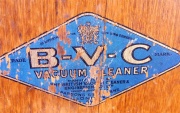British Vacuum Cleaner Co

of London, SW6. Head Office and Works. Branches throughout the United Kingdom. Telephone: Fulham 3333. Telegraphic Address: "Vacuumiser, 'Phone, London". (1937)
The idea of a vacuum cleaner originated from the mid-19th century. The first vacuum cleaners had to be operated manually. Two persons were needed for this: one to operate the bellows and the other to move the mouthpiece over the floor. The dust was blown into the an attached bag - like modern machines.
1860-1900 Crude bellows operated machines and unsuccessful experiments with suction sweepers.
1902 The Vacuum Cleaner Co was formed by Hubert Cecil Booth to exploit his patented innovation, the first mechanically-powered vacuum cleaner. The cleaning was offered as a service from a horse-drawn appliance parked outside the premises.
1903 Public company - British Vacuum Cleaner Co
1903 Wealthy society ladies threw 'vacuum cleaner parties'. Guests sipped their tea and lifted their feet for Booth's uniformed attendants to vacuum the carpet. After giving a vacuum demonstration at the Royal Mint, Booth, on leaving, was promptly stopped by the police. He had forgotten to empty the dust bag, which contained a large quantity of gold dust from the Mint.
1904 Take action for infringement of patents against Suction Cleaners and Lacy-Hulbert and Co [1]
1910 Professor Stanley Kent of University College, Bristol found 355,500,000 living organisms in just one gramme of dust extracted from Marlborough House, the home of HRH The Princess of Wales.
1910 Legal action against the London and South Western Railway who had used cleaners by some other company[2] [3]
c.1925 Name changed to British Vacuum Cleaner and Engineering Co
1926 Booth's British Vacuum Cleaner and Engineering Co (BVC) branded all their domestic vacuum cleaners under the famous Goblin trade name.






